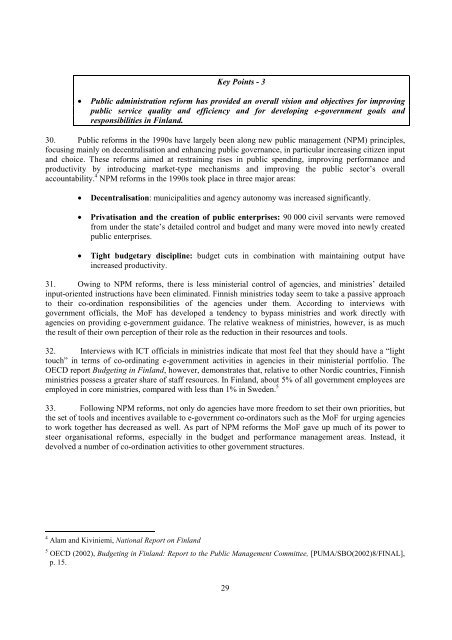e-GOVERNMENT IN FINLAND - ePractice.eu
e-GOVERNMENT IN FINLAND - ePractice.eu
e-GOVERNMENT IN FINLAND - ePractice.eu
Create successful ePaper yourself
Turn your PDF publications into a flip-book with our unique Google optimized e-Paper software.
Key Points - 3<br />
x Public administration reform has provided an overall vision and objectives for improving<br />
public service quality and efficiency and for developing e-government goals and<br />
responsibilities in Finland.<br />
30. Public reforms in the 1990s have largely been along new public management (NPM) principles,<br />
focusing mainly on decentralisation and enhancing public governance, in particular increasing citizen input<br />
and choice. These reforms aimed at restraining rises in public spending, improving performance and<br />
productivity by introducing market-type mechanisms and improving the public sector’s overall<br />
accountability. 4 NPM reforms in the 1990s took place in three major areas:<br />
x Decentralisation: municipalities and agency autonomy was increased significantly.<br />
x Privatisation and the creation of public enterprises: 90 000 civil servants were removed<br />
from under the state’s detailed control and budget and many were moved into newly created<br />
public enterprises.<br />
x Tight budgetary discipline: budget cuts in combination with maintaining output have<br />
increased productivity.<br />
31. Owing to NPM reforms, there is less ministerial control of agencies, and ministries’ detailed<br />
input-oriented instructions have been eliminated. Finnish ministries today seem to take a passive approach<br />
to their co-ordination responsibilities of the agencies under them. According to interviews with<br />
government officials, the MoF has developed a tendency to bypass ministries and work directly with<br />
agencies on providing e-government guidance. The relative weakness of ministries, however, is as much<br />
the result of their own perception of their role as the reduction in their resources and tools.<br />
32. Interviews with ICT officials in ministries indicate that most feel that they should have a “light<br />
touch” in terms of co-ordinating e-government activities in agencies in their ministerial portfolio. The<br />
OECD report Budgeting in Finland, however, demonstrates that, relative to other Nordic countries, Finnish<br />
ministries possess a greater share of staff resources. In Finland, about 5% of all government employees are<br />
employed in core ministries, compared with less than 1% in Sweden. 5<br />
33. Following NPM reforms, not only do agencies have more freedom to set their own priorities, but<br />
the set of tools and incentives available to e-government co-ordinators such as the MoF for urging agencies<br />
to work together has decreased as well. As part of NPM reforms the MoF gave up much of its power to<br />
steer organisational reforms, especially in the budget and performance management areas. Instead, it<br />
devolved a number of co-ordination activities to other government structures.<br />
4 Alam and Kiviniemi, National Report on Finland<br />
5<br />
OECD (2002), Budgeting in Finland: Report to the Public Management Committee, [PUMA/SBO(2002)8/F<strong>IN</strong>AL],<br />
p. 15.<br />
29
















